
Orthetrum villosovittatum, known as the fiery skimmer, is a species of dragonfly in the family Libellulidae. Its range is from the Moluccas, New Guinea and neighbouring islands as well as Australia. In Australia it is found in Victoria through eastern New South Wales and Queensland, north inland Queensland, Cape York Peninsula and north Northern Territory. It is a common species through most of its range.

Ceriagrion is a genus of damselfly in the family Coenagrionidae. Species of Ceriagrion are small to medium size, generally brightly coloured damselflies. They are found across the Old World, Africa, Asia and Australia.

Ceriagrion glabrum is a species of damselfly in the family Coenagrionidae. Its common names include common orange, common citril, common pond damsel, common waxtail, orange waxtail and gewone aljander. It is widespread in Africa, where it is found in habitats that are dominated by reeds.

Hemiphlebia mirabilis, commonly known as the ancient greenling, is a species of damselfly in the family Hemiphlebiidae. It is very small with a long, metallic-green body and clear wings. It is endemic to south-eastern Australia. Its natural swamp habitat is threatened by habitat loss.

Tramea is a genus of dragonflies in the family Libellulidae, the skimmers and perchers. Species of Tramea are found in tropical and subtropical regions around the globe. They typically have colored bases to their otherwise translucent hindwings. In particular when they fly, this creates the impression of their carrying bags at the start of their abdomens. They are known commonly as saddlebags or saddlebags gliders.

Ceriagrion cerinorubellum, commonly known as the orange-tailed marsh dart or bi-coloured damsel, is a medium-sized damselfly in the family Coenagrionidae. It is a very common species of damselflies in Asia.

Griseargiolestes albescens is a species of Australian damselfly in the family Megapodagrionidae. It is commonly known as a coastal flatwing.

Agriocnemis femina, the variable wisp or pinhead wisp, is a species of damselfly in the family Coenagrionidae. It is a small damselfly; mature males have a white pruinescence over their body, and a dark tail. It is found from India, through South-east Asia to islands in the Pacific. where it inhabits pools and stagnant water.

Indolestes tenuissimus is a species of damselfly in the family Lestidae, commonly known as the slender reedling. It is found in north-eastern Australia, New Guinea and on Aru.
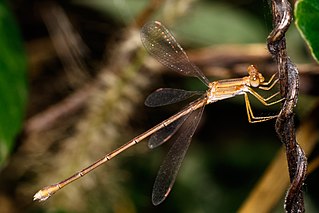
Lestes concinnus is a species of damselfly in the family Lestidae, the spreadwings. They are so named because they rest with their wings spread. This species is known commonly as the dusky spreadwing. It is a nomadic damselfly found in India, Southeast Asia as far as New Caledonia, and northern parts of Australia.
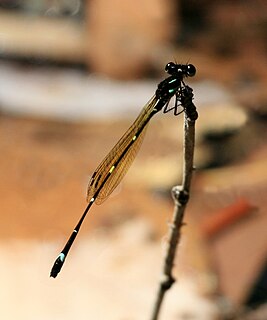
Nososticta solitaria is an Australian species of damselfly in the family Platycnemididae, commonly known as the fivespot threadtail. It is found only in north-eastern Australia.

Nososticta coelestina is an Australian species of damselfly in the family Platycnemididae, commonly known as the green-blue threadtail.

Rhadinosticta banksi is an Australian species of damselfly in the family Isostictidae, commonly known as the northern wiretail.

Nososticta fraterna is an Australian species of damselfly in the family Platycnemididae, commonly known as the northern threadtail.
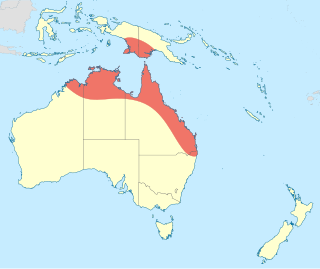
Pseudagrion cingillum is a species of damselfly in the family Coenagrionidae, commonly known as a northern riverdamsel. It is a medium-sized, blue and black damselfly. It is found in northern Australia and New Guinea, where it inhabits streams, pools and ponds.
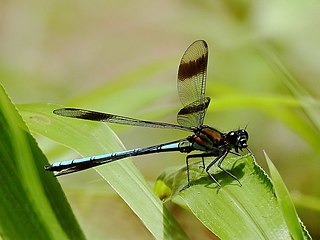
Diphlebia hybridoides is a species of Australian damselfly in the family Lestoideidae, commonly known as a giant rockmaster. It is endemic to north-eastern Queensland, where it inhabits streams in forests.
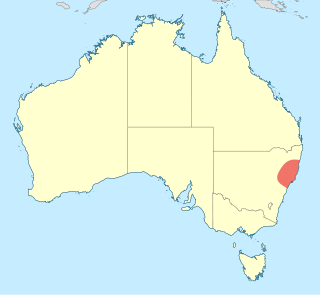
Griseargiolestes bucki is a species of Australian damselfly in the family Megapodagrionidae, commonly known as a turquoise flatwing. It is endemic to the Barrington Tops area of New South Wales, where it inhabits streams, bogs and seepages.

Griseargiolestes fontanus is a species of Australian damselfly in the family Megapodagrionidae, commonly known as a springs flatwing. It is endemic to south-eastern Queensland and north-eastern New South Wales, where it inhabits streams near their springs.

Episynlestes cristatus is a species of Australian damselfly in the family Synlestidae, commonly known as a tropical whitetip. It is endemic to north-eastern Queensland, where it inhabits streams in rainforest.

Synlestes weyersii is a species of Australian damselfly in the family Synlestidae, commonly known as a bronze needle. It is endemic to south-eastern Australia, where it inhabits streams and rivers.



























